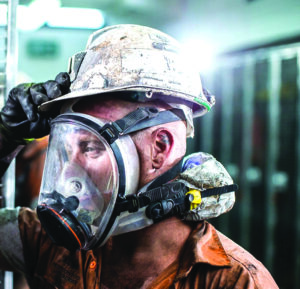
Developed in Australia, CleanSpace Respirators provide air on demand without the cumbersome hoses and battery packs. (Photo: CleanSpace)
New equipment and ideas will help miners avoid long-term exposure to coal dust
By Steve Fiscor. Editor-in-Chief
Several presentations given during the U.S. Coal Show, which was held recently in Pittsburgh, Pennsylvania, USA, discussed advancements in dust control. Respirable dust is the nemesis of the underground coal miner and the only way to avoid coal workers pneumoconiosis (black lung) is to avoid over exposure. Nothing is better for lungs than clean fresh air, and the only place to find that is outdoors on the surface.
The air passing through most modern mines today is much cleaner on average than it was 20 or 30 years ago. Improved ventilation and advances with rock dusting techniques along with water sprays on continuous miners and longwall shearers have helped considerably. With increased sampling, coal operators have a better understanding of how coal dust travels from the point where it is generated. There is, however, still room for improvement with dust control and no one should be working in an over-exposed environment.
The Positive Pressure Filter
In his presentation about the use of positive pressure filters underground, Tim Costa, director of safety solutions for CleanSpace, discussed a new type of face mask that provides enhanced respiratory protection. “Lungs are the most meaningful part of our body,” Costa said. “Without our lungs, we don’t survive. The thing about a chronic illness, like black lung, is that once you have it, it’s really hard to get rid of it. This is not a broken leg where you put a cast on it, and six to eight weeks later you can run again. This is black lung. And we know how it affects this industry.”
CleanSpace Respirators are based on positive pressure technology, similar to what is used in continuous positive air pressure (CPAP) applications. “The CleanSpace EX powered air purifying respirator (PAPR) offers a very high-level of protection,” Costa said. “It will also allow users to work comfortably and interact naturally in the underground work environment.”
Using a corded phone vs. the iPhone analogy, he compared the EX to older PAPR machines with a battery pack on the belt and a hose connected to a full-face mask. “Respirators haven’t changed in 30 years,” Costa said. “Some miners are still wearing systems with hoses and an 8-lb battery pack on their back in these tight environments. Why? Because they don’t think there’s anything else out there.”
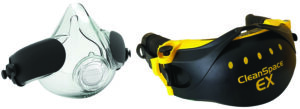
The EX with a half mask weighs 1.1 lb and takes seconds to don and doff. (Photo: CleanSpace)
CleanSpace is focused on mining, and the EX model, which is intrinsically safe, has been designed for use in underground coal. The CleanSpace respirators are based on air-sensing technology, meaning they are breath-responsive. “Our system gives you air when you need air,” Costa said. “It is not a constant flow system. It is not a negative pressure system. It senses pressure inside the mask, and it gives the user air on demand. Users are not struggling to breathe through a negative pressure mask.”
Originating from Australia, CleanSpace has been working with mines for close to 12 years. “Our engineers come from the biomedical field,” Costa said. “They spent a lot of time with workers in the pharmaceuticals field and we found a lot of those workers took a nap at the end of the day. They were napping because they were exhausted from trying to breathe through a negative pressure mask all day. Their oxygen levels were lower. Their productivity levels also decreased throughout the day. This investment can improve the health of the miner, increase productivity and boost morale.”
Costa said that CleanSpace has shipped 500 units in the last six months to mines in the eastern U.S.
The EX weighs 1.1 lb. “It has no belts, no hoses, no battery packs, and it has an assigned protection factor of 1,000,” Costa said. “The hose-mounted systems have an assigned protection factor of anywhere between 25 and 50. The EX offers 20 times more protection than the 8-lb weight on the miner’s back with hoses that can get entangled.”
The EX’s motor unit with a filter, which rests on the back of the neck, connects to a half mask. Donning and doffing takes seconds. The mask is made from medical grade silicone, which is extremely comfortable, Costa explained. “The air exits through the exhalation valves,” Costa said. “It will not fog safety glasses. If the seal is broken between the mask and the face, it just pumps out air. The user is under positive pressure at all times.” The filter captures 99.97% of the particulate matter above 0.3 microns.
Because it’s made of medical grade silicone, the user can throw it into a dishwasher. “They can throw it on the ground, step on it, sit on it, leave it in a locker, and guess what, every time they take it out, it’s going to be in the exact same form,” Costa said. “It works with 40 different cleaning solutions, everything from alcohol wipes to bleach wipes, or just soap and water. They are IP66 certified, which means they can be washed under cold water. The unit cannot be submerged.”
The EX is air sensing. It provides air when miners need air, and only when they need air. “There is no off button,” Costa said. “If you’re wearing it, it will work.
The filters, which come in a 3-pack, typically last multiple shifts in underground coal. CleanSpace also sells pre-filters, that wrap over the back of the unit.
The Mine Safety and Health Administration (MSHA) has a rigorous approval process. New electronic devices must pass MSHA’s petition for modification and CleanSpace has had 20 petitions approved in six to eight months. “We have had zero denied,” Costa said. “The reason we’ve had zero denied is because we meet every single qualification to go underground, and there are many.”
The mine will need to get its operations and safety team involved in the approval process, along with legal advisors, Costa explained. “We’re comfortable with this process because we have to do this for our gas meters,” Costa said.
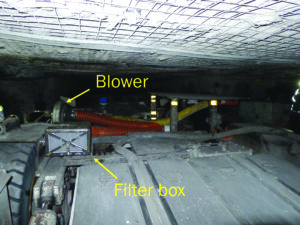
A filter box with a blower in plumbed into the RamCar’s hydraulic system. It pushes air through a plenum welded to the roof of the operator’s cab. (Photo: NIOSH)
Fully charged, the EX will operate for seven to nine hours. The miners can bump charge them during breaks, 15 minutes of charging usually provides an additional hour. The typical battery life is 5,000 hours before users start to see a diminished life. The units come with a two-year warranty.
Air Canopies for Shuttle Cars
Hua Jiang, Ph.D., a research engineer for the National Institute for Occupational Safety and Health (NIOSH), presented work that he and Randy Reed. Ph.D., senior mining research engineer with NIOSH, recently completed on the development of a canopy air curtain (CAC) for shuttle cars.
The CAC was originally designed to protect on-board continuous miner (CM) operators. It uses a hydraulically-power blower to push filtered air through a plenum to flood the area around the miner with filtered air. Previous NIOSH research showed that it reduced respirable dust for the CM operators by 30% to75%. With the help of J.H. Fletcher, the system was successfully modified for roofbolter operators. Those units reduced respirable dust by 60%. Now the field test results for the CAC mounted on a RamCar are showing equally promising results.
Under a research contract, NIOSH has been working with Marshall University and J.H. Fletcher to test the CAC on a RamCar. Lab tests showed a reduction of as high as 80% for the RamCar operators and the researchers moved to field trials.
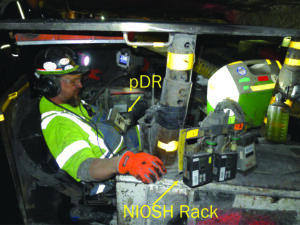
Dust sampling devices were placed on the operator and just outside the cab. The side of the plenum can be seen just above his head. (Photo: NIOSH)
A CAC was installed on a RamCar, which was operating with two other RamCars and a CM and a roofbolter in a room-and-pillar section. The blower was plumbed into the RamCar’s hydraulic system. The blower was expected to run continuously when the RamCar was operating. A filter was added to the blower inlet and an 18- x 18-in. plenum was welded into the roof of the RamCar’s canopy. The CM’s scrubber exhaust was located on the same side as the RamCar’s operator cab.
Air samples were taken inside and just outside the RamCar, on the intake and return side of the CM, and at the feederbreaker. The sampling array was a combination of Personal Data Rams (PDR 1000s) and Continuous Personal Dust Monitors (CPDMs). A PDR-1000 and a CPDM were placed inside the canopy. A PDR-1000 and two gravimetric samplers were placed just outside the canopy. NIOSH Sampling Packs were placed at the feederbreaker, and on the intake and return side of the CM.
During the first week, the CAC didn’t operate, Jiang explained. “The hydraulic arrangement on the RamCar was not capable of powering the blower while the machine was operating,” Jiang said. “We added a two-stage hydraulic pump to the system, piggy-backing the blower, and it worked.”
Sampling began the following week, and the researchers had two successful days before things went awry. During those two days, the airflow under the canopy was more than 300 cubic feet per minute (cfm). On the third day, while attempting to correct the settings, the knob on the regulator broke, Jiang explained.
While the researchers were conducting the sampling survey, they also performed a time study of the RamCar. As one would expect, most of the RamCar’s time was spent tramming between the CM and the feederbreaker.
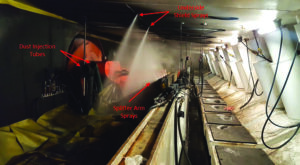
Test performed at the PMRD’s Longwall Gallery determined the effectiveness of under-shield sprays. (Photo: NIOSH)
The results indicated an overall 34% and 31% reduction in respirable dust for the CAC on the RamCar. At the CM, however, where the operator would sit near the scrubber exhaust, the CAC reduced respirable dust levels from an over exposure level to less than 1.5 milligram per cubic meter. In that area, the respirable dust reduction was 57% to 65% while the CM loaded the RamCar. The CAC provided a 35% – 45% reduction of respirable dust concentrations while unloading RamCar, and 20% – 27% reduction of respirable dust concentrations while tramming. The time the operators spent underneath the canopy ranged from 41% – 66% of the total time it operated. “The CAC provided effective protection when the operator is underneath the canopy,” Jiang said.
Jiang noted that higher plenum air velocities provided greater protection. In addition to maintaining high airflow through plenum, he suggested cleaning the filter media regularly and adding a 2- to 3-in. lip around perimeter of plenum.
Underside Shield Sprays on the Longwall
As it cuts coal, the shearer generates considerable respirable dust on the longwall face. That’s why coal operators must move 30,000 cfm of clean air on the longwall. Scott Klima, a mining engineer with NIOSH’s Pittsburgh Mining Research Division (PMRD) discussed the current research taking place to reduce dust on the longwall face using underside shield sprays.
In addition to the ventilation, longwall operators also use water sprays to combat overexposure to dust. Sprays are installed on the cutter drums and the splitter arms on the shearer, and some mines have sprays mounted under the shield and directed toward the face. “These underside shield sprays create a moving curtain of water, preventing dust from reaching the personnel walkway, but they can have a negative impact on respirable dust control if improperly sequenced,” Klima said.
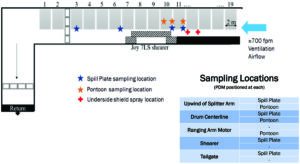
Sampling locations were placed strategically in the Longwall Gallery. (Graphic: NIOSH)
To determine the most effective arrangement for underside shield sprays, one that would prevent the dust cloud from forming and reaching the walkway, NIOSH researchers replicated the traveling water curtain in the PMRD’s Longwall Gallery. They hoped to prove that properly installed and aligned sprays could expand the overall effective zone of the shearer’s directional spray system, which are automatically activated and deactivated based on the location of the shearer.
Previous testing was completed without a shearer-clearer system, Klima explained. “We needed to determine if the shearer-clearer water sprays had a positive or negative interaction with the splitter arm and under-side shield sprays,” Klima said. “We found that the underside shield sprays decreased respirable dust concentrations, while splitter arm sprays alone did not help lower dust concentrations.”
Mining personnel are best protected at the upwind splitter arm, drum centerline and the spill plate and pontoon locations, Klima said. “Proper alignment of all longwall water sprays is critical toward effectively decreasing respirable dust exposure,” Klima said. “Splitter arm sprays continue to be ineffective when used alone. Tailgate sprays did not appear to have an impact on dust concentrations observed during testing.” The key takeaway, Klima said, is that any combination of parameters for underside shield sprays provided improved conditions on the longwall face for mining personnel.




